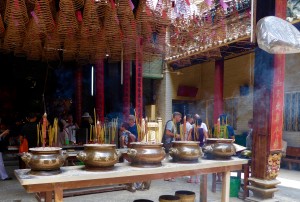Ho Chi Minh City (Saigon), Vietnam March 22, 2016
Until this week, my gut reaction when hearing the word “Vietnam” was to cringe, recalling the 1970s and how our family sweated out the draft process, worried that brother Jim and his friends would wind up fighting a war. Thankfully our family was spared that fate, but many others were not so fortunate.
Having now spent 3 days in Saigon, I have a very different reaction to the word “Vietnam” and it is a feeling of hope. So many residents of Vietnam are under the age of 45 (and therefore didn’t personally experience the years of war with other nations), so plugged into the world via the internet and social media, and so literate and educated, that this is a society that seems to be going headlong right into a bright future.
While Vietnam is governed by a Communist party, the signs of capitalism flourish in Saigon – all manner of things are bought and sold, and the Vietnam economy prospers from its exports (cashews, coffee, rice, tea, etc.).
However, there are the rich and the poor, and everyone with whom we spoke frequently mentioned the gap (for example, “that’s a building where only rich people can buy apartments”). The tour guides and drivers we met talked often about saving money so that their children could attend good (private) schools and so that their parents could be taken care of (for many, especially non-government employees such as the farmers who have been a big part of the economy in the past, there are no pensions or old-age public health care arrangements, so the children who are now working wind up paying the hospital/doctor/other bills).
Cranes and building projects are everywhere, and the landscape varies from massive construction sites (office parks, factories, residential complexes) along the roadways that lead into Saigon City from the port and outer areas to tree lined boulevards and beautiful parks in the main part of the city, with French neo-classical colonial architecture next door to modern buildings, crumbling old buildings, and virtually anything else you can imagine.
We heard from locals during our visit that although the country is Communist-ruled, freedom of religion (90% of Vietnamese are Buddhists) and other freedoms are the norm; certainly there is freedom from road regulations – more motorbikes, scooters and bicycles that you can ever imagine, flying down roads in all directions, without many traffic lights or other guides, but remarkably low traffic accident rates.
There are 51 dialects spoken in Vietnam, and certainly the country has absorbed a lot of territories in its history. One lecturer on the ship summed up the country’s history this way: The Vietnamese fought the Chinese for 1000 years, the French for 100 years, and the Americans for 10 years. We noticed and heard from locals that white skin is valued for women; ladies generally will try hard not to let the sun make them tan.
During our visit, we saw an enormous wholesale market in Chinatown that looked and operated like something from a hundred years ago, shops on downtown streets that had the brands, look and feel of 5th Avenue NYC, and ladies outside those shops squatting down on the sidewalk cooking waffles over small open fires and selling them to passers-by. We heard that those in Saigon “live on the streets” in the sense that this is where life takes place, and it certainly seems that way. It is a vibrant city, and one we’d love to come back and explore more.
We also took a trip on the Mekong River – a very large river that is the lifeblood of southern Vietnam; it supplies the water for a large area (the Delta) that produces all types of crops. The Mekong River runs from China in the north down through 6 countries; China has dammed a lot of the river and this is affecting the downstream countries and the productivity of the river as salt water from the South China Sea becomes more of its content and affects its use in growing crops.
The Mekong is a muddy brown river, lined with old stilt houses and lean-tos that are still occupied although they look uninhabitable. In some of those old houses there are beekeepers, rice paper makers, wine makers and others who produce items through family labor in what we would call cottage industry – very old-school. We visited a floating market on the Mekong, and learned that commerce on the river is conducted via boat – you either motor/row/sail to a vendor, or the vendor comes to you. Picturesque but not pristine; the river is polluted with trash as are many of the roads we saw.
We are on our way to central and northern Vietnam, and we’ll see if the years have treated this area differently – the capital (Hanoi) has been a capital for many years, and it will be interesting to see if the free market influence is as strong as in Saigon.
Hope that you are all doing well.
Best,
MA

Banner for the Water Puppet Show in Saigon –
an old art in which the puppets are manipulated by people behind a curtain, who have sticks connected to the puppets to make them move; very skillful work!

A Buddhist temple in Chinatown; you can see joss sticks in the front, and spiral incense coils hanging from the ceiling, with purple and red papers containing the petitions requesting prayers. We saw many tourists but also many locals worshipping at the temple. Because so many people came to Vietnam by boat, this temple is dedicated to the gods and goddesses of water travel. There is also a shrine to the god of business (who rewards his worshippers with prosperity). The temple is open air, and you can see a plastic cover over the fan in the upper right corner.

On the Mekong River at the floating market a lady cuts open a coconut and offers it to our guide for a drink; notice how the vendor squats low – we saw this everywhere as the way people hang out (not sitting or standing). In the background you see housing the businesses that line the river.

another boat at the floating market, this one filled with fruit; the vendor is bending down in the left side of the picture, wearing the traditional conical hat. A husband and wife will live on the boat, getting replenishment inventory from their farms/gardens, and returning to their homes on land after they are done selling the crops.
